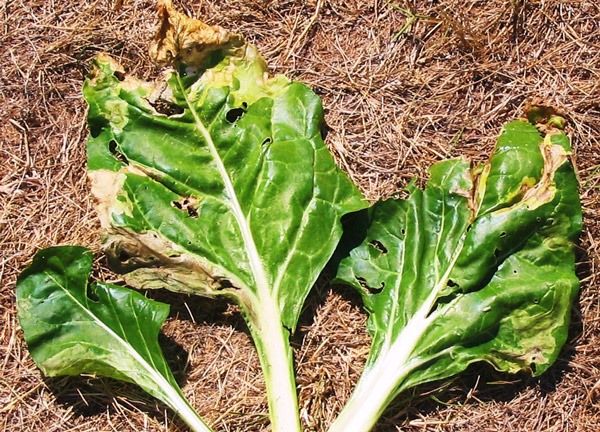Leaf miners are one of the most common insect problems in Pacific Northwest gardens. They affect a large number of vegetable crops including spinach, chard, beets, cole crops, cucurbits, tomatoes and bush beans as well as ornamental plants and weeds.
Life cycle
Although a common plant problem, leaf miners are fairly host-specific and result from the larvae of a variety of flies. Adults are often small black to gray flies with yellow stripes and clear wings; however, adult flies are rarely noticed. It is the larva and the damage that it does that gets all the attention.
Leaf miner adult flies lay eggs, usually on the underside of leaves on susceptible plants. After hatching, the larvae burrow between the upper and lower surfaces of the leaf to produce tunnels or “mines.” Later, these tunnels enlarge, forming white to gray blotches and streaks on the leaf surface, distorting the leaf shape. The leaves usually develop yellow or brown areas of dead tissue as the infection progresses.
The life cycle is completed when the mature larva burrows through the leaf, falls to the ground where it pupates and emerges from the soil as a fly. When fully mature, the larvae (about ¼ inch long) are often white to pale yellow or green in color.
In years with favorable conditions, leaf miners can go through multiple generations. Damage from the first generation can be seen in late April through June with a possible second generation appearing in mid-August through late September.
Controlling leaf miners
Although no chemicals are recommended for control of leaf miners in the home garden, other control methods are numerous and varied.
Good weed control is critical and will eliminate hosts for this pest. Weeds such as pigweed, lambsquarters, plantain, chickweed and nightshade should be destroyed and discarded.
For garden plants, infected leaves can be picked off and thrown in the garbage; they should not be composted. You can squeeze the leaf to kill the larva before discarding it.
The most important control method is crop rotation. Since leaf miner larvae overwinter in the soil, do not plant susceptible crops in areas where leaf miners were found last year.
Screening plants before adult flies emerge in April through May will minimize the fly’s access to susceptible plants (and can provide protection from the cold).
Put down floating or fixed row covers, such as Reemay®, Agribond® or a similar material in early April. If there is a warm early spring, you may need to push this forward to late March.
Do not cover areas where leaf miners have been found in the past. They could emerge from the soil and find themselves trapped under the cover, with no other choice but to feast on the leaves of your prized plants.
Watch out for this pest. If you see it, immediately take steps to prevent future crops from being affected.
Plant clinic help
For more free gardening help, visit a local Master Gardener plant clinic. The clinics are held on Saturdays at the Demonstration Garden on 2711 Woodcock Road in Sequim from 9 a.m.-1 p.m. and on Mondays at the Clallam County Courthouse, 223 E. Fourth St., in Port Angeles from 9 a.m.-1 p.m.
Bring your gardening questions, samples from problem plants and garden pests.
Pearl of wisdom
Removing and destroying leaves affected by leaf miner larvae is an effective means of control.
If you are diligent with this effort and do it before the larvae burrow out of the leaf and fall on the ground, you can wipe out the next generation of leaf miners or at least limit its size.
Bob Cain is a WSU-certified Clallam County Master Gardener.



